Experimental Study of Primary Atomization Characteristics of Sonic Air-Assist Atomizers
Abstract
:Featured Application
Abstract
1. Introduction
2. Materials and Methods
3. Results
3.1. Flow Dynamics
3.1.1. Gas Flow Study
3.1.2. Twin-Fluid Study
3.2. Sheet Breakup Dynamics
3.2.1. Breakup Morphology
3.2.2. Spray Angle
3.2.3. Breakup Length
4. Discussion
5. Conclusions
Author Contributions
Funding
Data Availability Statement
Acknowledgments
Conflicts of Interest
References
- Leboucher, N.; Laporte, G.; Carreau, J.L. Effect of the inner gas jet on annular liquid sheet atomization. Proceeding of the 21st Annual Conference on Liquid Atomization and Spray Systems, Taiwan, China, 8–9 November 2007; pp. 1–5. [Google Scholar]
- Fu, H.; Li, X.; Prociw, L.A.; Hu, T.C.J. Experimental investigation on the breakup of annular liquid sheets in two co-flowing airstreams. Proceeding of the 1st International Energy Conversion Engineering Conference IECEC, Portsmouth, Virginia, 17–21 August 2003; pp. 1–11. [Google Scholar] [CrossRef]
- Leboucher, N.; Roger, F.; Carreau, J.L. Disintegration process of an annular liquid sheet assisted by coaxial gaseous coflow(S). At. Sprays 2010, 20, 847–862. [Google Scholar] [CrossRef]
- Kawano, S.; Hashimoto, H.; Togari, H.; Ihara, A.; Suzuki, T.; Harada, T. Deformation and breakup of an annular liquid sheet in a gas stream. At. Sprays 1997, 7, 359–374. [Google Scholar] [CrossRef]
- Choi, C.J. Disintegration of Annular Liquid Sheet with Core Air Flow-Mode Classification. Int. J. Fluid Mech. Res. 1997, 24, 399–406. [Google Scholar]
- Adzic, M.; Carvalho, I.S.; Heitor, M.V. Visualization of the disintegration of an annular liquid sheet in a coaxial air-blast injector at low atomizing air velocities. Opt. Diagn. Eng. 2001, 5, 27–38. [Google Scholar]
- Li, X.; Shen, J. Experiments on annular liquid jet breakup. At. Sprays 2001, 11, 557–573. [Google Scholar] [CrossRef]
- Berthoumieu, P.; Lavergne, G. Video Techniques Applied to the Characterization of Liquid Sheet Breakup. J. Vis. 2001, 4, 267–275. [Google Scholar] [CrossRef]
- Leboucher, N.; Roger, F.; Carreau, J.L. Characteristics of the spray produced by the atomization of an annular liquid sheet assisted by an inner gas jet. At. Sprays 2012, 22, 515–542. [Google Scholar] [CrossRef]
- Zhao, H.; Xu, J.L.; Wu, J.H.; Li, W.F.; Liu, H.F. Breakup morphology of annular liquid sheet with an inner round air stream. Chem. Eng. Sci. 2015, 137, 412–422. [Google Scholar] [CrossRef]
- Kulkarni, V.; Sivakumar, D.; Oommen, C.; Tharakan, T.J. Liquid sheet breakup in gas-centered swirl coaxial atomizers. J. Fluids Eng. Trans. ASME 2010, 132, 0113031–0113037. [Google Scholar] [CrossRef]
- Sivakumar, D.; Kulkarni, V. Regimes of spray formation in gas-centered swirl coaxial atomizers. Exp. Fluids 2011, 51, 587–596. [Google Scholar] [CrossRef]
- Kihm, K.D.; Chigier, N. Effect of Shock Waves on Liquid Atomization of a Two-Dimensional Airblast Atomizer. At. Sprays 1991, 1, 113–136. [Google Scholar] [CrossRef]
- Park, B.K.; Lee, J.S.; Kihm, K.D. Kihm Comparative study of twin-fluid atomization using sonic or supersonic gas jets. At. Sprays 1996, 6, 285–304. [Google Scholar] [CrossRef] [Green Version]
- Heck, U.; Fritsching, U.; Bauckhage, K. Gas flow effects on twin-fluid atomization of liquid metals. At. Sprays 2000, 10, 25–46. [Google Scholar] [CrossRef]
- Mates, S.P.; Settles, G.S. A study of liquid metal atomization using close-coupled nozzles, part 2: Atomization behavior. At. Sprays 2005, 15, 41–59. [Google Scholar] [CrossRef]
- Zapryagaev, V.; Kiselev, N.; Gubanov, D. Shock-wave structure of supersonic jet flows. Aerospace 2018, 5. [Google Scholar] [CrossRef] [Green Version]
- Liepmann, H.W.; Roshko, A. Elements of Gas Dynamics, 2001th ed.; Dover Publications: New York, NY, USA, 2001. [Google Scholar]
- Liu, A.B.; Reitz, R.D. Mechanisms of air-assisted liquid atomization. At. Sprays 1993, 3, 55–75. [Google Scholar] [CrossRef]
- Stapper, B.E.; Sowa, W.A.; Samuelsen, G.S. Stapper An Experimental Study of the Effects of Liquid Properties on the Breakup of a Two-Dimensional Liquid Sheet. J. Eng. Gas Turbines Power 1992, 114. [Google Scholar] [CrossRef]
- Lavergne, G.; Trichet, P.; Hebrard, P.; Biscos, Y. Liquid Sheet Disintegration and Atomization Process on a Simplified Airblast Atomizer. J. Eng. Gas Turbines Power 1993, 115, 461–466. [Google Scholar] [CrossRef]
- Issac, K.; Missoum, A.; Drallmeier, J.; Johnston, A. Atomization experiments in a coaxial coflowing Mach 1.5 flow. AIAA J. 1994, 32, 1640–1646. [Google Scholar] [CrossRef]
- Karnawat, J.; Kushari, A. Spray evolution in a twin-fluid swirl atomizer. At. Sprays 2008, 18, 449–470. [Google Scholar] [CrossRef]
- Schneider, C.A.; Rasband, W.S.; Eliceiri, K.W. NIH Image to ImageJ: 25 years of image analysis. Nat. Methods 2012, 9, 671–675. [Google Scholar] [CrossRef] [PubMed]
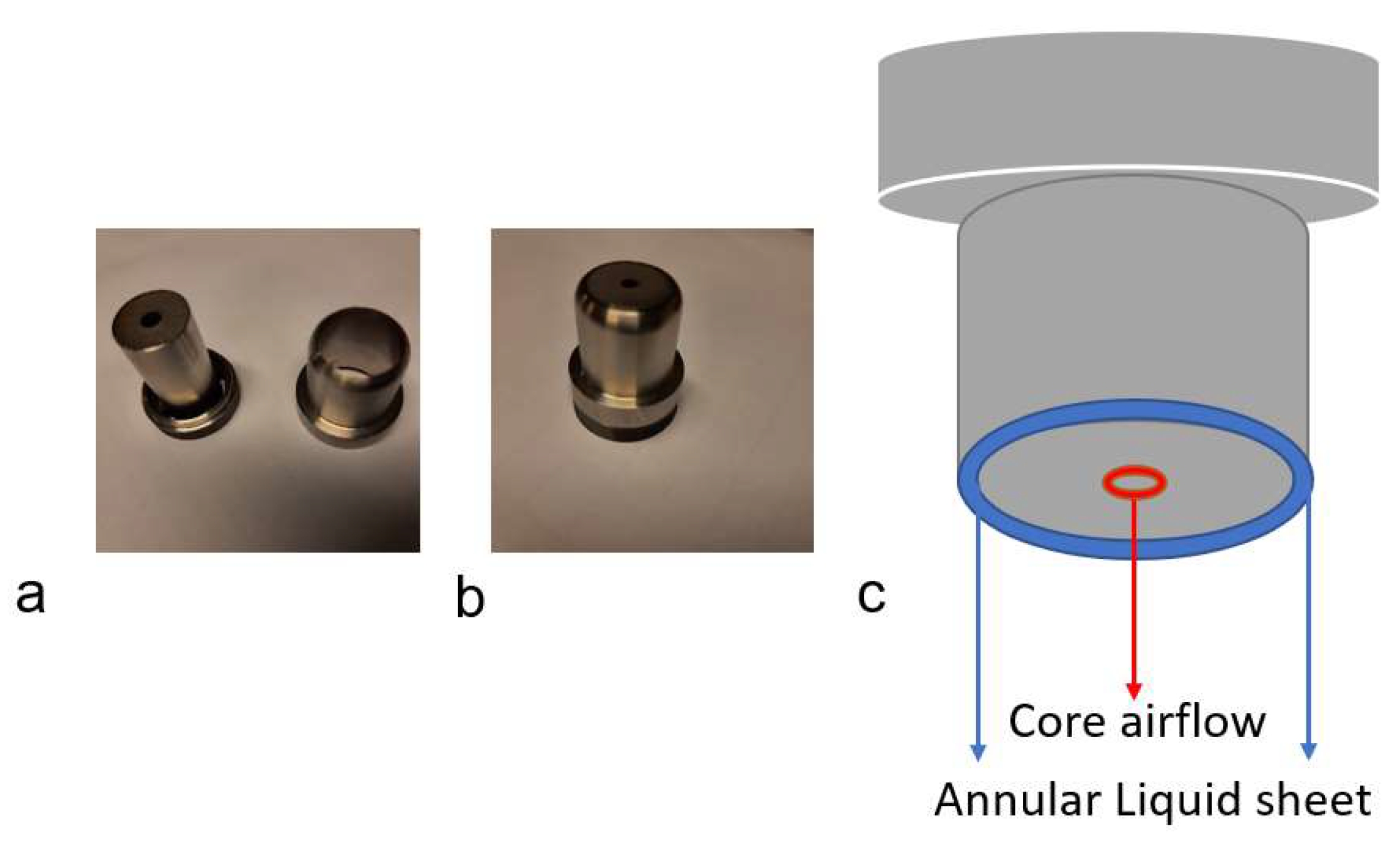
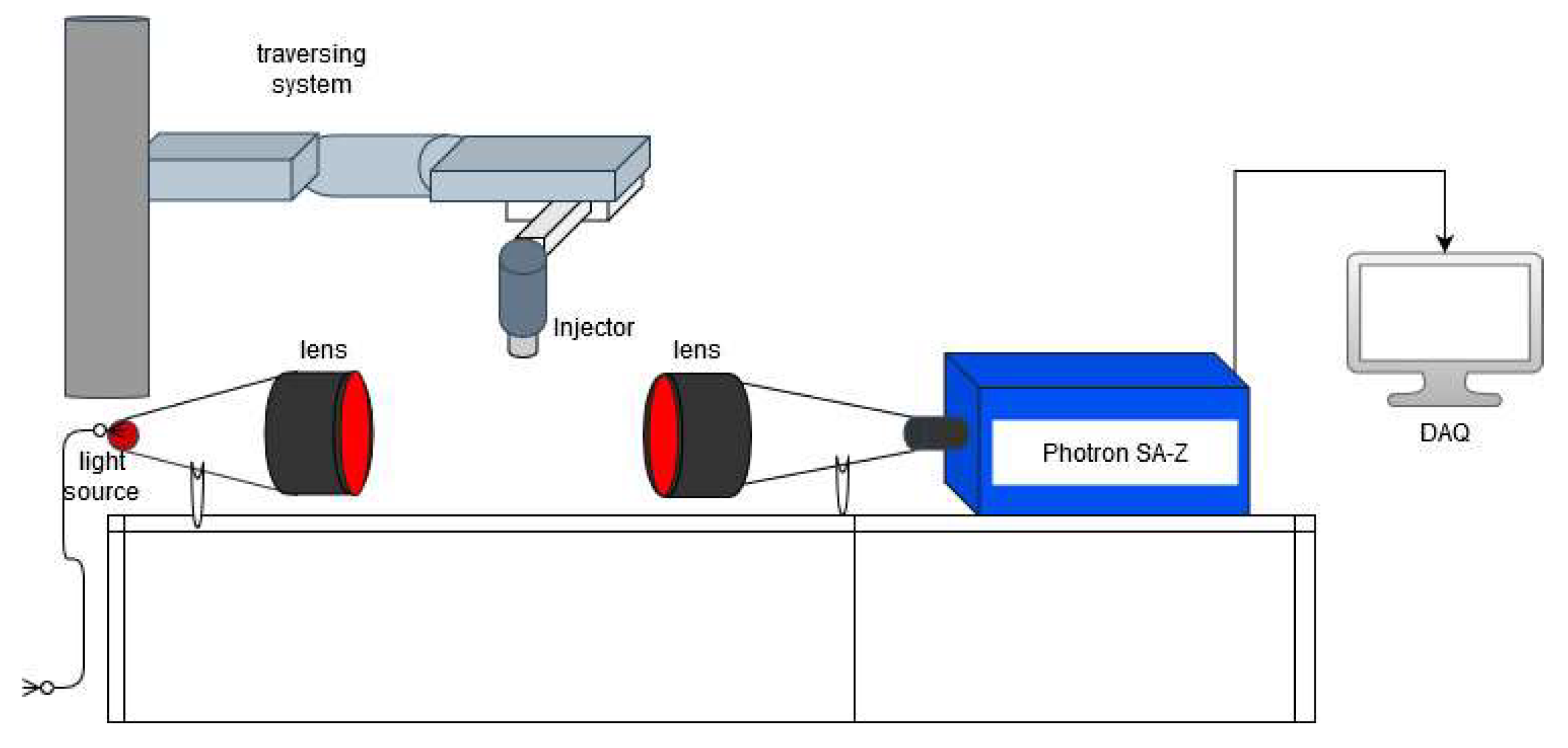


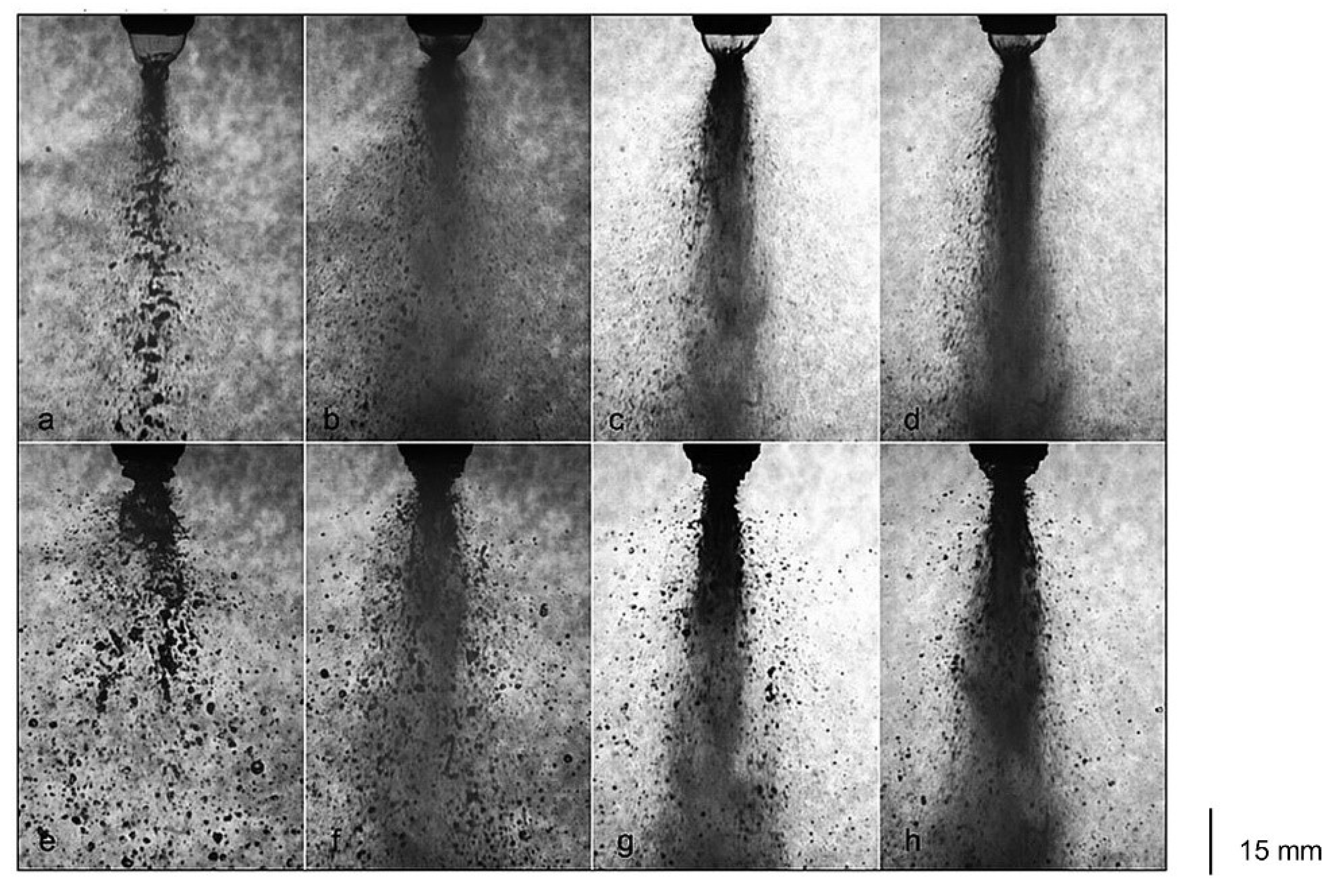
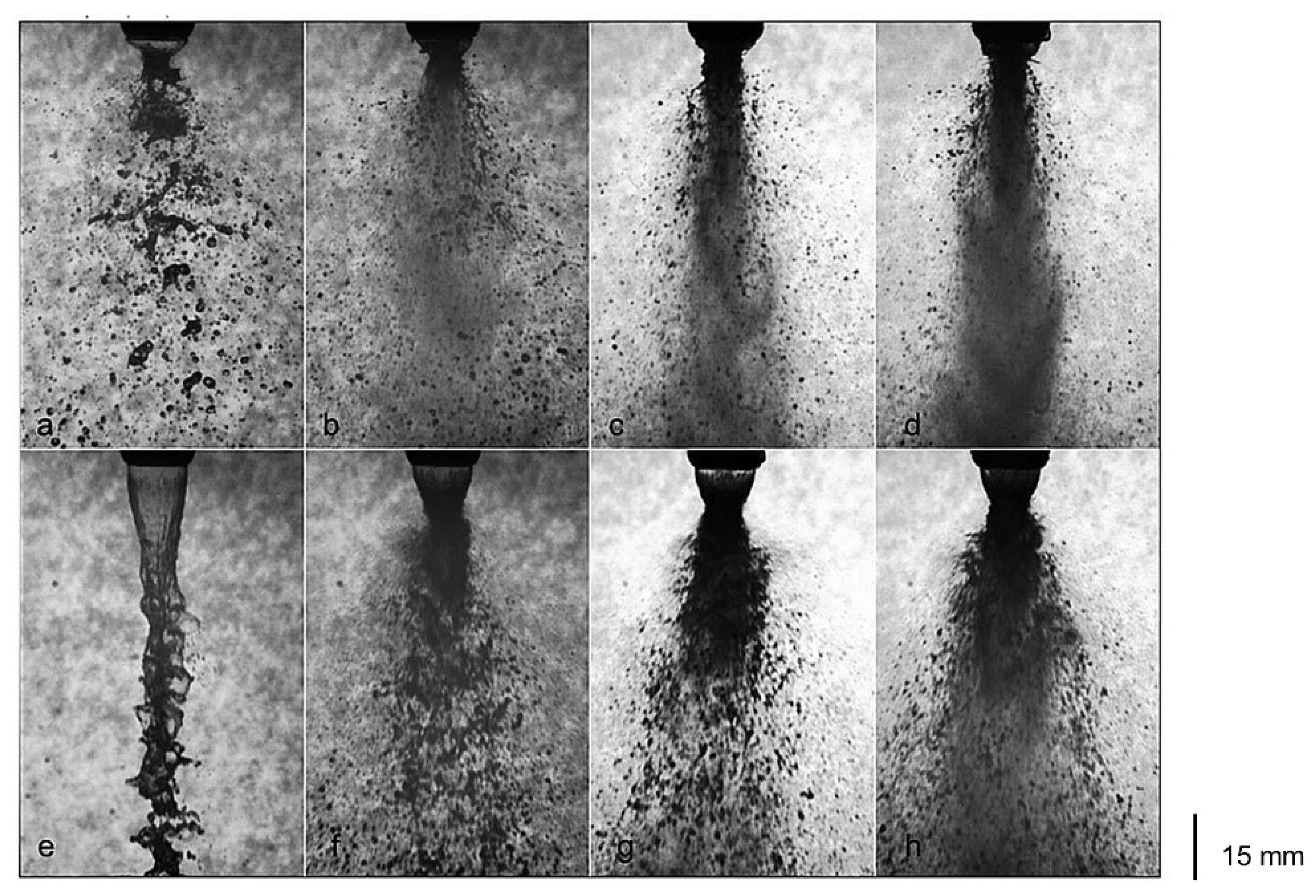
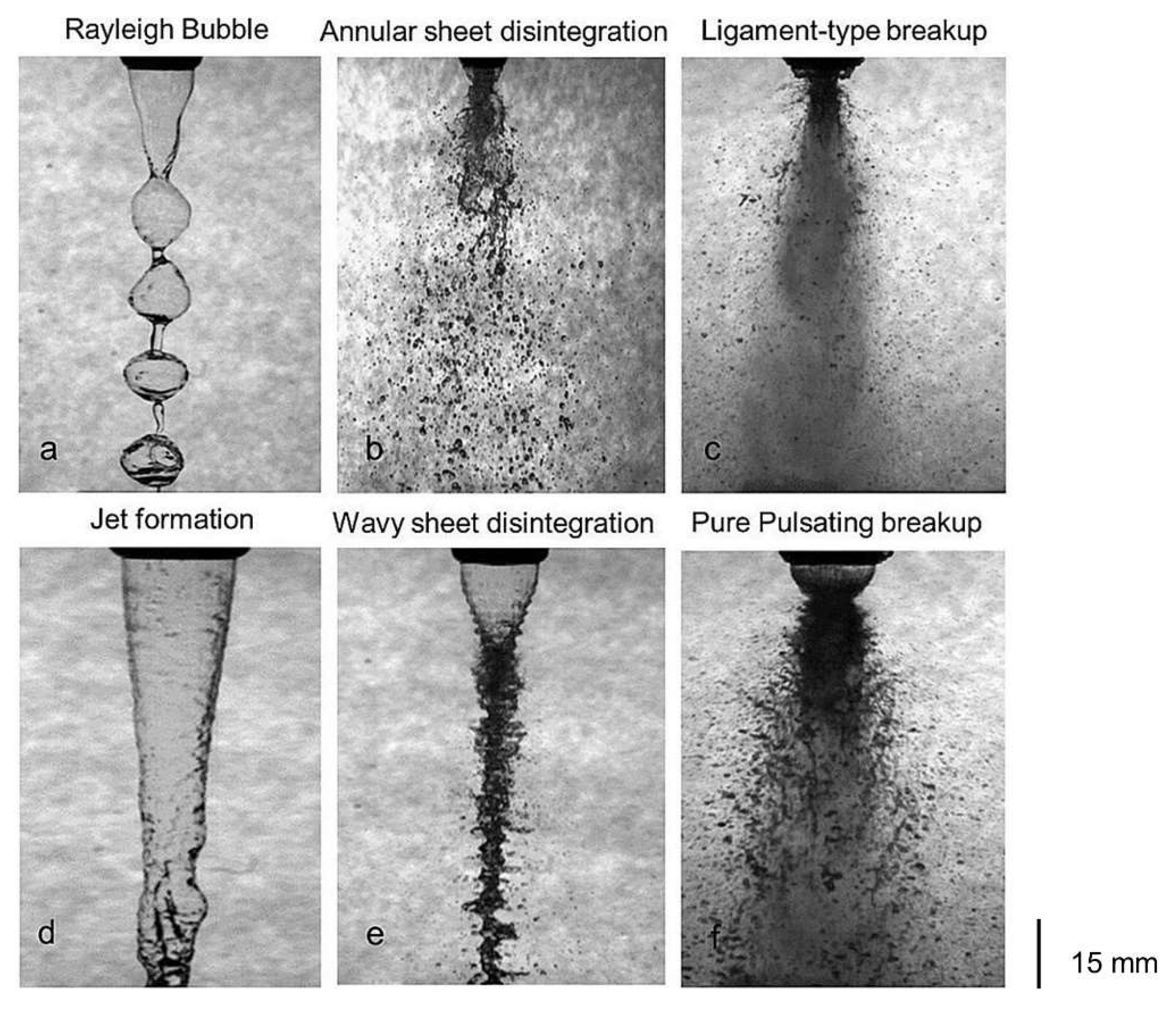
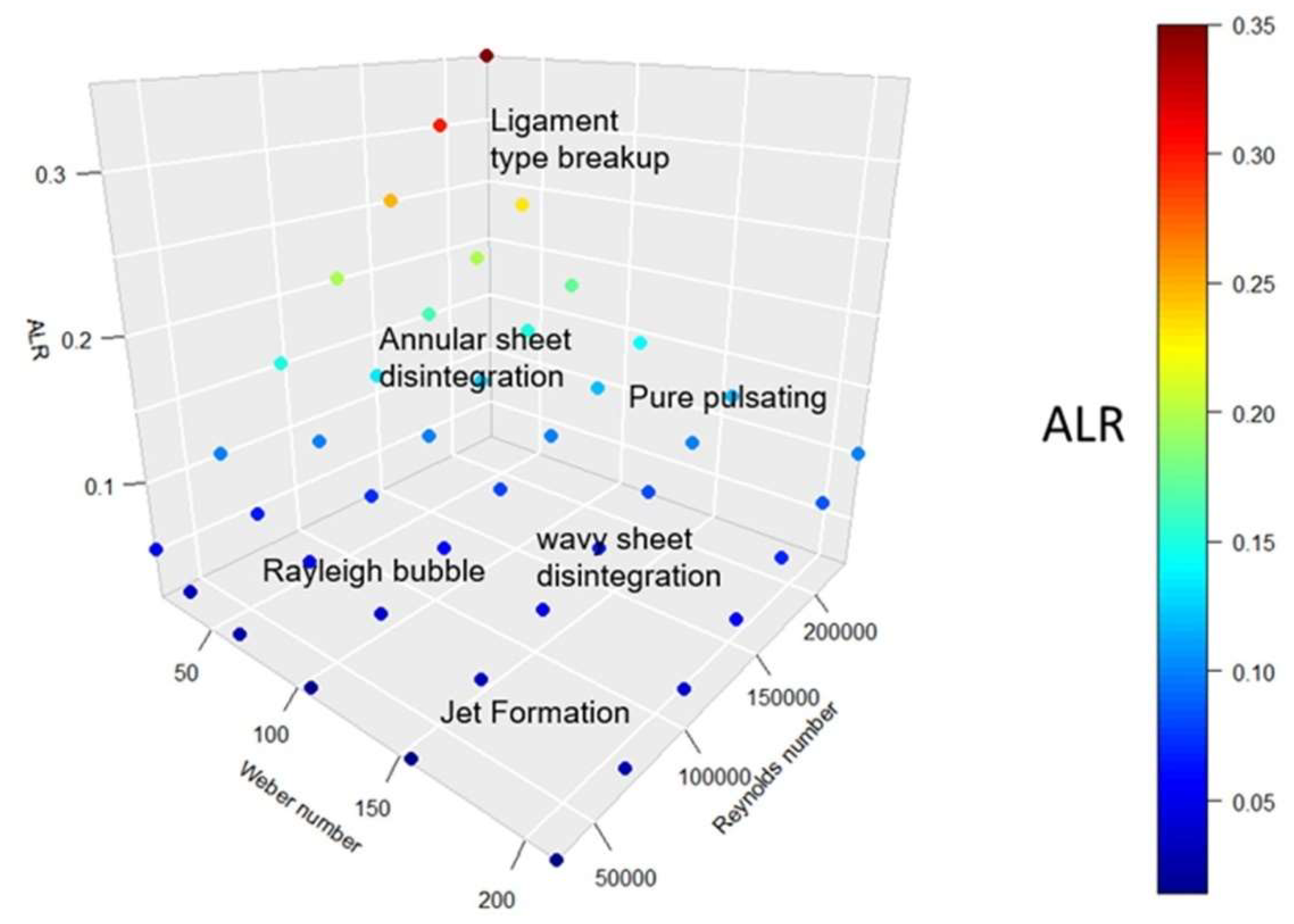
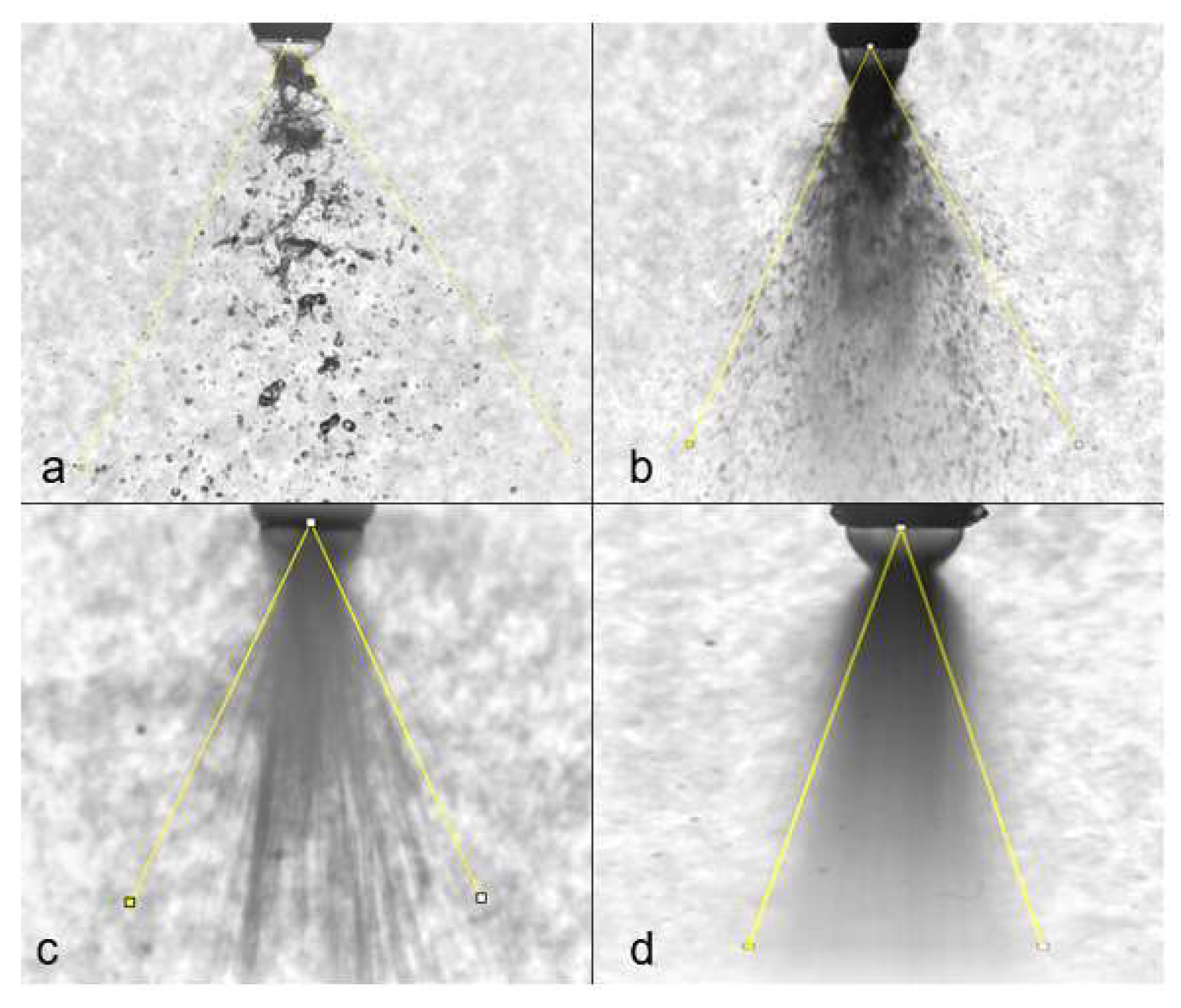

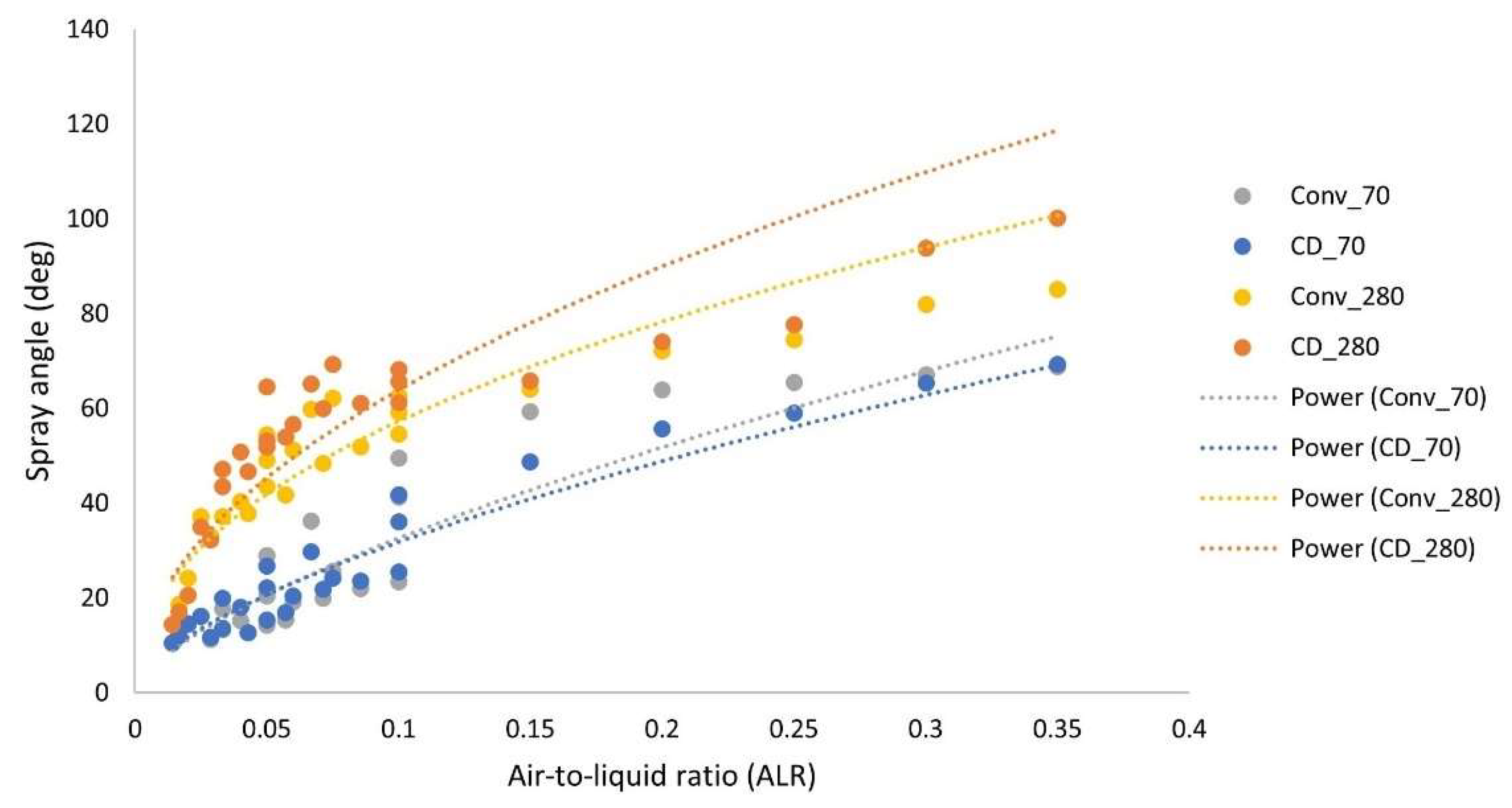
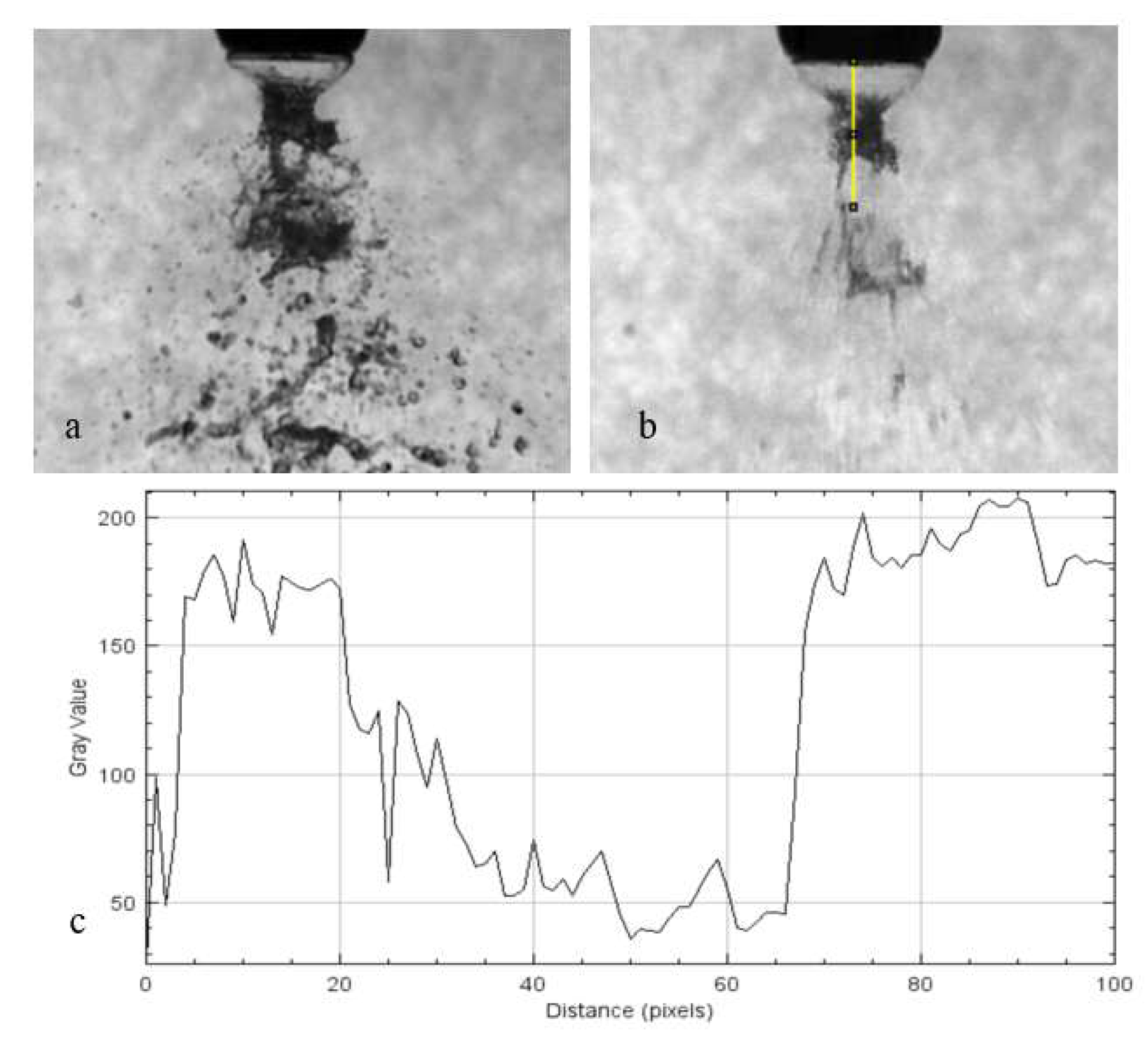


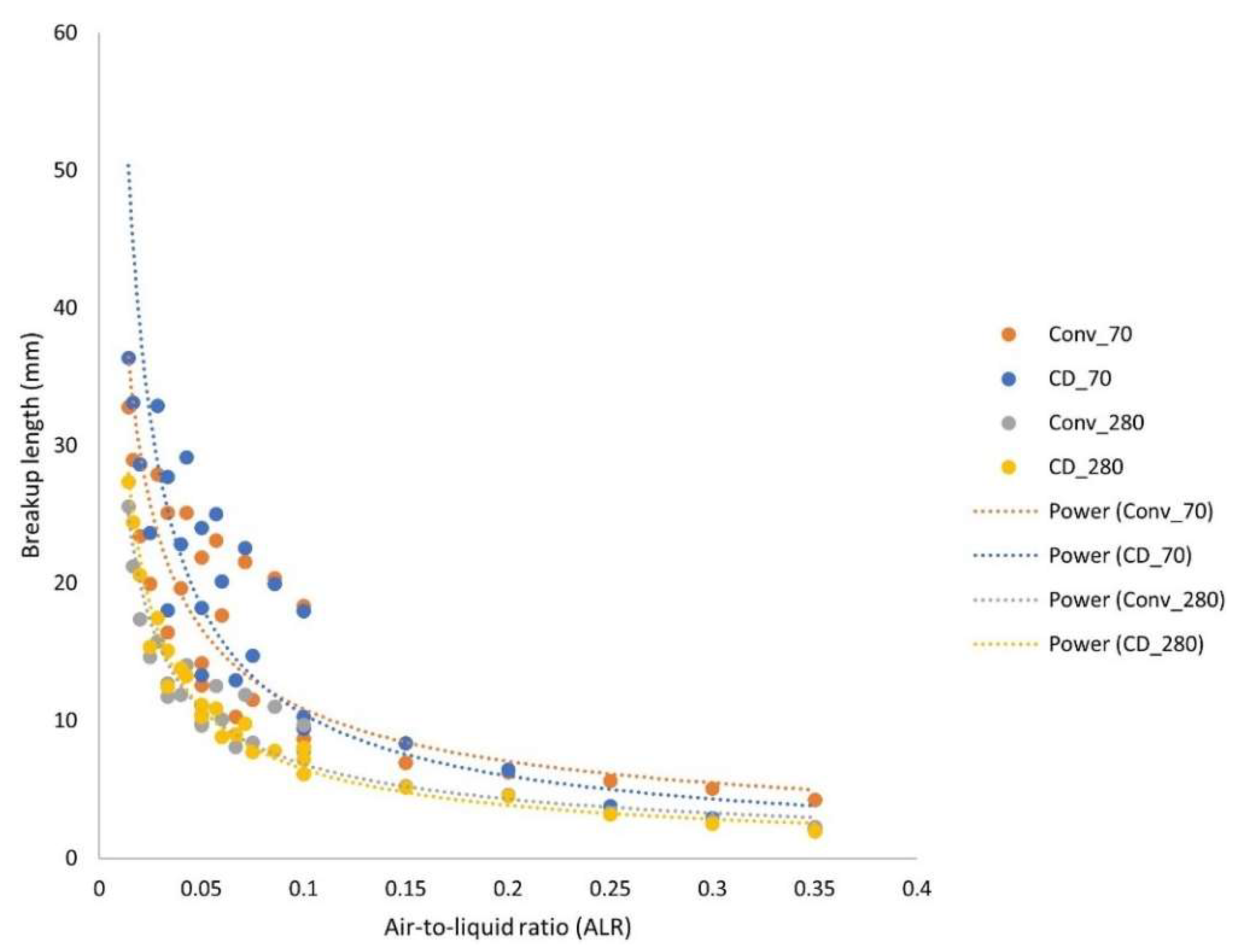
| Quantity | Range |
|---|---|
| Airflow rate 1 | 5–35 |
| Water flow rate 1 | 100–350 |
| Air-to-liquid ratio (ALR) | 0.014–0.35 |
| Liquid Weber number (Wel) | 17.2–844.9 |
| Air Reynolds number (Reg) | 33,000–229,000 |
Publisher’s Note: MDPI stays neutral with regard to jurisdictional claims in published maps and institutional affiliations. |
© 2021 by the authors. Licensee MDPI, Basel, Switzerland. This article is an open access article distributed under the terms and conditions of the Creative Commons Attribution (CC BY) license (https://creativecommons.org/licenses/by/4.0/).
Share and Cite
Sikka, R.; Vågsæther, K.; Bjerketvedt, D.; Lundberg, J. Experimental Study of Primary Atomization Characteristics of Sonic Air-Assist Atomizers. Appl. Sci. 2021, 11, 10444. https://doi.org/10.3390/app112110444
Sikka R, Vågsæther K, Bjerketvedt D, Lundberg J. Experimental Study of Primary Atomization Characteristics of Sonic Air-Assist Atomizers. Applied Sciences. 2021; 11(21):10444. https://doi.org/10.3390/app112110444
Chicago/Turabian StyleSikka, Raghav, Knut Vågsæther, Dag Bjerketvedt, and Joachim Lundberg. 2021. "Experimental Study of Primary Atomization Characteristics of Sonic Air-Assist Atomizers" Applied Sciences 11, no. 21: 10444. https://doi.org/10.3390/app112110444






